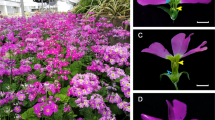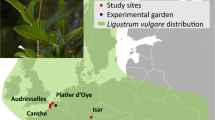Abstract
Distyly inLinum tenuifolium L. is associated with a high degree of self-incompatibility. Breakdown in this system has occurred without the morphological rearrangement expected as the result of cross-over within the distyly supergene. Pollen-flow in both distylous and monomorphic populations is leptokurtic. A high proportion of intra-flower pollination occurs. Pollen production per ovule is reduced in the self-compatible race. Mean seed-set is increased. Individuals of the self-compatible race produce less vegetative growth and require a shorter time to reach reproductive maturity under cultivation. Increased fecundity appears to provide the selective advantage promoting the breakdown of self-incompatibility in this species. This is achieved through a massive shift of resources toward female reproductive function in plants of the monomorphic race. Subsequent colonization by this race has led to its increased distribution in C. & S. Europe.
Similar content being viewed by others
References
Bateson, W., Gregory, R. P., 1905: On the inheritance of heterostylism inPrimula. — Proc. R. Soc. Lond.B. 76, 581–586.
Baker, H. G., 1966: The evolution, functioning and breakdown of heteromorphic incompatibility systemsI. ThePlumbaginaceae. — Evolution20, 349–368.
Bawa, K. S., Beach, J. H., 1981: Evolution of sexual systems in flowering plants. — Ann. Miss. Bot. Gard.68, 254–278.
Beach, J. H., Bawa, K. S., 1980: Role of pollinators in the evolution of dioecy from distyly. — Evolution34, 1138–1143.
Casper, B. B., Charnov, E. L., 1982: Sex allocation in heterostylous plants. — J. Theor. Biol.96, 143–149.
Charlesworth, D., Charlesworth, B., 1981: Allocation of resources to male and female function in hermaphrodites. — Bot. J. Linn. Soc.15, 57–74.
Charnov, E. L., 1982: The Theory of Sex Allocation. — Princeton: Princeton University Press.
Crosby, J. L., 1979: Selection of an unfavourable gene-complex. — Evolution3, 212–230.
Cruden, R. W., 1976: Fecundity as a function of nectar production and pollenovule ratios. — InBurley, J., Styles, B. T., (Eds.): Variation, Breeding and Conservation of Tropical Forest Trees. — London, New York: Academic Press.
, 1977: Pollen-ovule ratios: a conservative indicator of breeding systems in flowering plants. — Evolution31, 32–46.
Dale, M. F. B., Ford-Lloyd, B. V., 1983: Reproductive characters associated with breeding behaviour inBeta sect.Beta (Chenopodiaceae). — Pl. Syst. Evol.141, 277–283.
Dowrick, V. P. J., 1956: Heterostyly and homostyly inPrimula obconica. — Heredity10, 219–236.
Dulberger, R., 1981: Dimorphic exine sculpturing in three distylous species ofLinum (Linaceae). — Pl. Syst. Evol.139, 113–121.
Ganders, F. R., 1974: Disassortative pollination in the distylous plantJepsonia heteranda. — Can. J. Bot.52, 2401–2406.
, 1979: The biology of heterostyly. — New Zeal. J. Bot.17, 607–635.
Garnock-Jones, P. J., 1981: Change of adaptations from entimophily to autogamy inParahebe linifolia (Scrophulariaceae). — Pl. Syst. Evol.137, 195–201.
Levin, D. A., 1968: The breeding system ofLithospermum caroliniense: adaptation and counteradaptation. — Am. Nat.102, 427–441.
, 1984: Inbreeding depression and proximity-dependant crossing success inPhlox drummondii. — Evolution38, 116–127.
Lewis, D., 1949: Incompatibility in flowering plants. — Biol. Rev.24, 472–496.
, 1954: Comparative incompatibility in Angiosperms and Fungi. — Adv. Genet.6, 235–285.
, 1982: Incompatibility, stamen movement and pollen economy in a heterostylous tropical forest tree,Cratoxylum formosum (Guttiferae). — Proc. R. Soc. Lond. B.214, 273–283.
Lewis, D., Crowe, L., 1958: Unilateral interspecific incompatibility in flowering plants. — Heredity12, 233–256.
Lloyd, D. G., 1979a: Parental strategies of angiosperms. — New Zeal. J. Bot.17, 595–606.
, 1979b: Evolution toward dioecy in heterostylous populations. — Pl. Syst. Evol.131, 71–80.
, 1980a: Benefits and handicaps of sexual reproduction. — Evol. Biol.13, 69–110.
, 1980b: Demographic factors and mating in angiosperms. — InSolbrig, O. T., (Ed.): Demography and Evolution in Plant Populations. — Oxford: Blackwell.
Martin, F. W., 1967: Distyly, self-incompatibility and evolution inMelochia. — Evolution21, 493–499.
Mather, K., 1950: The genetical architecture of heterostyly inPrimula sinensis. — Evolution4, 340–352.
Moore, D. M., Lewis, H., 1965: The evolution of self-pollination inClarkia xantiana. — Evolution19, 104–114.
Nicholls, M. S., 1985a: A systematic study of theLinum tenuifolium L. group (Linaceae). — Bot. J. Linn. Soc. (submitted January, 1985).
- 1985b: Pollen-flow, population composition and the adaptive significance of distyly inLinum tenuifolium L. (Linaceae). — Biol. J. Linn. Soc. (in press).
Ornduff, R., 1969: The significance of reproductive biology for taxonomy. — Taxon18, 104–114.
, 1970: Incompatibility and the pollen economy ofJepsonia parryi. — Amer. J. Bot.57, 1036–1041.
, 1979: Pollen flow in a population ofPrimula vulgaris Huds. — Bot. J. Linn. Soc.78, 1–10.
, 1980: Heterostyly, population composition, and pollen flow inHedyotis caerulea. — Amer. J. Bot.67, 95–103.
Philipp, M., Schou, O., 1981: An unusual heteromorphic incompatibility system. Distyly, self-incompatibility, pollen load and fertility inAnchusa officinalis (Boraginaceae). — New Phytol.89, 693–703.
Queller, D. C., 1984: Pollen-ovule ratios and hermaphrodite sexual allocation strategies. — Evolution38, 1148–1151.
Rogers, C. M., 1979: Distyly and pollen dimorphism inLinum suffruticosum L. (Linaceae). — Pl. Syst. Evol.131, 127–132.
Sobrevilla, C., Ramirez, N., Enrech, N. X. de, 1983: Reproductive biology ofPalicourea fendleri andP. petiolaris (Rubiaceae), heterostylous shrubs of a tropical cloud forest. — Biotropica15, 161–169.
Solbrig, O. T., 1981: The population biology of the genusViola 5. Life history dynamics of two New England species growing in a variable environment. — In:Scudder, G. G. E., Reveal, J. L., (Eds.): Evolution Today. Proceedings of the Second International Congress of Systematic and Evolutionary Biology. — Pittsburg: Hunt Institute for Botanical Documentation.
Vuilleumier, B. S., 1967: The origin and evolutionary development of heterostyly in the angiosperms. — Evolution21, 210–226.
Waser, N. M., Price, M. V., 1983: Optimal and actual outcrossing in plants, and the nature of plant-pollinator interaction. — In:Jones, C. E., Little, R. J., (Eds.): Handbook of Experimental Pollination Biology. — New York: Van Nonstrand Reinhold.
Willson, M. F., 1983: Plant Reproductive Ecology. — New York: Wiley-Interscience.
Wyatt, R., 1984: Evolution of self-pollination in granite outcrop species ofArenaria (Caryophyllaceae) III. Reproductive effort and pollen-ovule ratios. — Syst. Bot.9, 432–440.
Author information
Authors and Affiliations
Rights and permissions
About this article
Cite this article
Nicholls, M.S. The evolutionary breakdown of distyly inLinum tenuifolium (Linaceae). Pl Syst Evol 150, 291–301 (1985). https://doi.org/10.1007/BF00984203
Received:
Issue Date:
DOI: https://doi.org/10.1007/BF00984203




